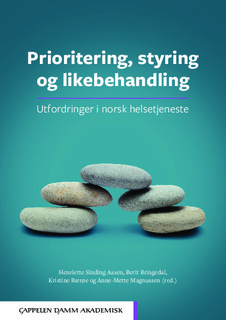| dc.contributor.author | Magnussen, Anne-Mette | |
| dc.contributor.author | Sudmann, Tobba Therkildsen | |
| dc.contributor.editor | Aasen, Henriette Sinding | |
| dc.contributor.editor | Bringedal, Berit | |
| dc.contributor.editor | Bærøe, Kristine | |
| dc.contributor.editor | Magnussen, Anne-Mette | |
| dc.coverage.spatial | Norway | nb_NO |
| dc.date.accessioned | 2019-01-21T11:11:41Z | |
| dc.date.available | 2019-01-21T11:11:41Z | |
| dc.date.created | 2018-04-16T14:31:13Z | |
| dc.date.issued | 2018 | |
| dc.identifier.citation | Magnussen, A.-M. & Sudmann, T. T. (2018). Rettslig regulering og e-helse. I H. S. Aasen, B. Bringedal, K. Bærøe og A.-M. Magnussen (Red.), Prioritering, styring og likebehandling: Utfordringer i norsk helsetjeneste. | nb_NO |
| dc.identifier.isbn | 978-82-02-56935-8 | |
| dc.identifier.uri | http://hdl.handle.net/11250/2581468 | |
| dc.description.abstract | The health services in Norway are subject to extensive legal regulation to ensure fair distribution of healthcare. In this chapter, we question whether the growing importance of e-health / digitalization of public services in general can support the legal regulation. Access to specialist health services requires interaction between the different organizational levels in the health service, as well as face-to-face health encounters between patients and physicians. The analytical concept «barriers to interaction» is used to discuss the relationship between legal regulation and e-health, more precisely how use of health-related information on Internet impact on these processes. Barriers are here understood in relation to making contact, to competency and efficiency in interaction between service users and services providers. Access to Internet and knowledge about digital health resources can change the impact of the barriers and affect access to specialist health services. E-health literacy are increasingly important, but varies with age, gender and education. The development of e-health may increase barriers for some, and lower them for others. E-health changes the organization of health care, and provide access to quality assured health-related information. Because the e-health field changes very quickly, researchers, patients and healthcare personnel must monitor and act upon wanted and unwanted consequences of e-health. | nb_NO |
| dc.language.iso | nob | nb_NO |
| dc.publisher | Cappelen Damm Akademisk | nb_NO |
| dc.relation.ispartof | Prioritering, styring og likebehandling: Utfordringer i norsk helsetjeneste | |
| dc.rights | Navngivelse 4.0 Internasjonal | * |
| dc.rights.uri | http://creativecommons.org/licenses/by/4.0/deed.no | * |
| dc.title | Rettslig regulering og e-helse | nb_NO |
| dc.title.alternative | Rettslig regulering og e-helse | nb_NO |
| dc.type | Chapter | nb_NO |
| dc.description.version | publishedVersion | nb_NO |
| dc.rights.holder | © 2018 Anne-Mette Magnussen og Tobba Therkildsen Sudmann | nb_NO |
| dc.subject.nsi | VDP::Medisinske Fag: 700::Helsefag: 800 | nb_NO |
| dc.source.pagenumber | 236-258 | nb_NO |
| dc.source.journal | Prioritering, styring og likebehandling: Utfordringer i norsk helsetjeneste | nb_NO |
| dc.identifier.doi | 10.23865/noasp.33 | |
| dc.identifier.cristin | 1579597 | |
| dc.relation.project | Norges forskningsråd: 229141 | nb_NO |
| cristin.unitcode | 203,3,60,0 | |
| cristin.unitname | Institutt for sosialfag og vernepleie - Bergen | |
| cristin.ispublished | true | |
| cristin.fulltext | original | |
| cristin.qualitycode | 1 | |

